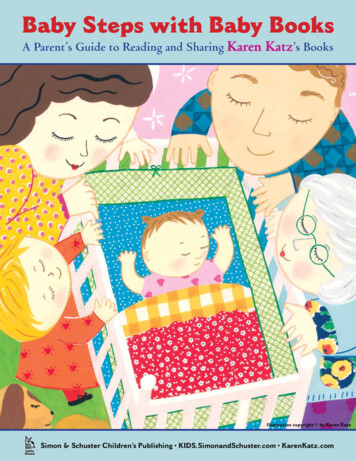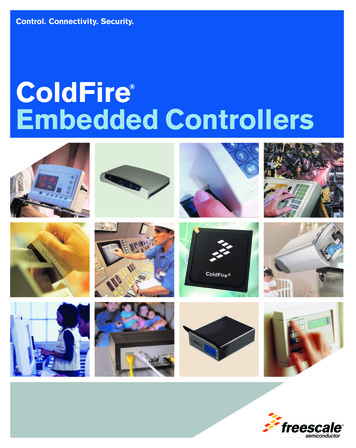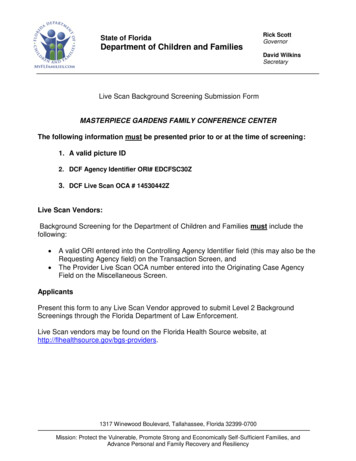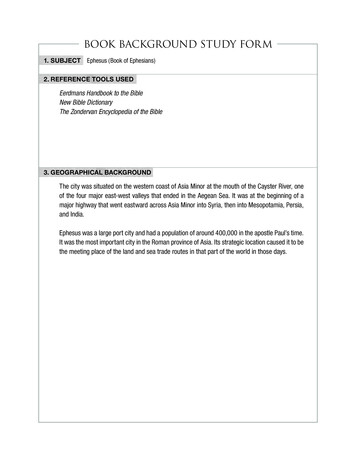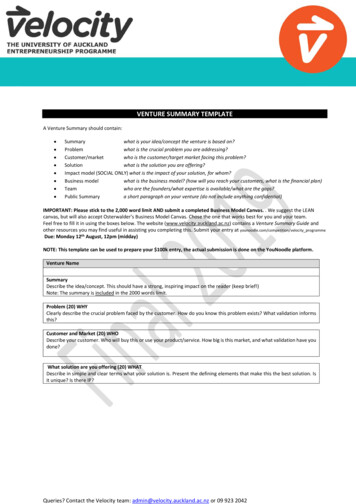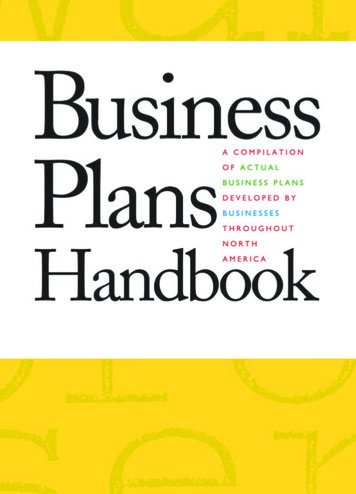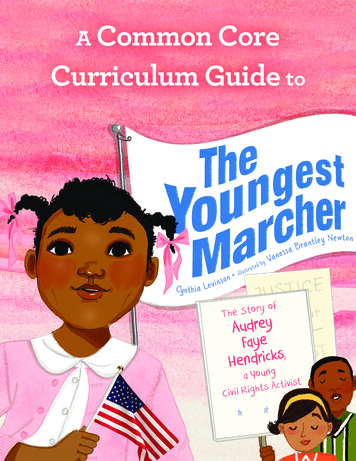
Transcription
The Youngest Marcher:The Story of Audrey Faye Hendricks, A Young Civil Rights ActivistWritten by Cynthia LevinsonIllustrated by Vanessa Brantley NewtonHardcover: 9781481400701 Ebook: 9781481400718Background/SummaryAudrey Faye Hendricks was nine-years-old when she became actively involved in the Civil Rights Movement.Talk of freedom, equality, and protest was in the air as she was growing up. When her parents hostedministers such as Dr. Martin Luther King Jr., Fred Shuttlesworth, and James Bevel for dinner, Audrey heardtalk about ending segregation in Birmingham, Alabama, and she wanted to be part of making this happen.After all, she had experienced the impact of segregation in her daily life and she wanted to see things change.When Dr. King spoke at meetings in Audrey’s church, he asked the people who attended to resist unjust lawsby marching and picketing. Because this resistance was unlawful, they would get arrested, filling up thejails and making further arrests of protesters impossible. But fearing for their jobs and safety, the adultsrefused. So instead, Jim Bevel offered a different idea. He suggested that children should fill the jails. That’swhen Audrey boldly stepped forward.As the youngest protester, Audrey faced hunger, horrible conditions, and humiliation in jail. Yet she andthousands of other children who volunteered to march filled the jail cells to capacity, making furtherarrests impossible. After one full week in jail, Audrey was allowed to return home, and two months laterthe segregation laws in Birmingham were lifted, enabling black people to walk into stores, movies, andrestaurants and be served just like everybody else. It was a stunning victory for equal rights, and AudreyFaye Hendricks was part of it.2
Discussion Questions/ActivitiesKey Ideas and DetailsThe discussion questions and activities below draw on Common Core State Standards (CCSS) for readinginformational text (RI) that ask children to ask and answer questions about key details in a text (RI.K–3.1),identify the main topic and key details that support it (RI.K–3.2), and describe the relationship between aseries of events, concepts, or ideas (RI.K–3.3).1.What did Audrey learn about segregation laws when grown-ups talked during supper?What did she think about these laws?2.How did segregation affect Audrey’s life? In what ways were black people treated differentlyfrom white people?3.Where and when does this story take place? Why does this matter?4.When Mike visited Fred’s church, what did he say about segregation and how to resist it?What was his plan?5.How did grown-ups respond to Mike’s plan? Why?6.How did Audrey respond when Jim suggested a new idea? What do you think of her response?7.Describe Audrey’s experience in jail. Discuss the following:8. Her treatment by the matron The food she was given The bed she slept in Going outdoors with cell mates Being questioned by four white menWhy were some protesters sopping wet when taken to jail? How was their experiencedifferent from Audrey’s?9.How did things change by the fifth day Audrey was in jail? How did things change after shereturned home?10.What does the author think about Audrey’s story? How do you know? Vanessa Brantley Newtown3
Craft and StructureTo learn about craft and structure, the CCSS asks us to help students learn and understand vocabulary wordsand phrases (RI.K–3.4), think about the features of nonfiction text (RI.K–3.5), and assess the author’s point ofview (RI.K–3.6). The questions and activities below emphasize these understandings.1.Looking Closely at Interesting Sentences. What makes readers pay attention to an author’swriting? It could be the descriptive words and phrases the author uses, the rhythm or soundof the sentences when read aloud, or the new information presented. See the InterestingSentences Activity sheet on page 5 to determine what makes a sentence interesting.2.Examining the Author’s Note. In the author’s note, Cynthia Levinson provides moreinformation about Audrey Faye Hendricks. Discuss what she tells you about the following: Audrey’s return home from jail How the Children’s March affected America What the author learned from her meeting with Audrey Faye Hendricks3.Creating Magnet Summaries. Here’s how to create Magnet Summaries. First, begin with akey word that explains the topic. You can think of this word as a magnet that attracts otherrelated words. Second, list other words and phrases that describe and explain the magnetword. Third, use as many words and phrases as possible to write a magnet summary aboutthe topic.Here is an example:unjust lawsBirminghamtextbooksAudrey Fay HendricksSEGREGATIONbuselevatormovieice cream parlorMagnet Summary: Because of the unjust segregation laws in Birmingham, Alabama, Audrey FayeHendricks received old, hand-me down textbooks. She paid for a bus ride at the front entrance of thebus and then had to walk off and enter through the back. She could not sit down and be served insidea local ice cream parlor, ride the main elevator of a department store, or sit where she pleased in amovie theater. Audrey wanted this treatment to change.Check out the Magnet Summaries Activity Sheet on page 6 to try some of your own.4
INTERESTING SENTENCES ACTIVITY SHEETExamine each of the sentences below and write down what you notice.What makes each sentence interesting to read?In a voice as taut as steel cables, as smooth as glass, he intoned, “[S]egregation . . . is morally wrongand sinful.”What I notice:She twisted in her pew to see which grown-ups would walk down the aisle, volunteer for jail. But theymostly stayed put, eyes staring at their feet, hands on their knees. Feet, hands, and knees didn’t move.What I notice:If nobody protested, Mike’s plan would fail. Police could keep arresting anyone, anytime, foranything, forever.What I notice:Audrey leaped to her feet. “I want to go to jail,” she declared. Momma looked deep and saw that Audrey’seyes begged, Please. “Okay,” Momma said.What I notice:After seven days, Audrey went home. Her momma and daddy wrapped their arms tight around her,washed the jail off her, and for dinner . . . hot rolls, baptized in butter!What I notice:
MAGNET SUMMARIES ACTIVITY SHEETHere’s how to create Magnet Summaries. First, begin with a key word that explains the topic(the word(s) in bold). You can think of this word as a magnet that attracts other related words.Second, list other words and phrases that describe and explain the magnet word (supplied here for you).Third, use as many words and phrases as possible to write a magnet summary about the topic.Try writing magnet summaries for the examples below.unjust lawvolunteersprotestdisobeyMike’s Planmarchpicketget arrestedfill the jailschildrenpaddy wagonpolicematronJailMagnet Summary:bare mattress and thin sheetquestionedhungry and tiredfilled up all the roomsMagnet Summary:segregation laws wiped off the bookshomeBirminghamstoresChangesblack and white togetherlike everybody elserestaurantsMagnet Summary:Create your own magnet word and related words. Write a magnet summary for your word choices.Illustrate your magnet summary.
Integration of InformationThe Common Core State Standards ask students to use both the illustrations and details in the text to describekey ideas and to show how images contribute to and clarify a text (e.g., where, when, why, and how key eventsoccur). (RI.1–4.7).1.Learning from Words and Illustrations. The words and illustrations work together to explaina key idea and the details that support it. Examine the pages below to see how this is done.Audrey knew all about segregation.Every Monday night, Audrey and her momma and daddyand her aunts, uncles, and cousins joined neighbors andfriends at Fred’s church for worship, fellowship, andtestimony. She sang and swayed along with theMovement Choir, her voice spirited andspiritual. “Black and white toge-e-ther, weshall overcome.” For once, she didn’thave to keep still.She knew to pay the driverat the front of the bus,then step off and walkaround to the back door.Drink from the fountainwith the dirty bowl andwarm water.Use the freight elevator atdepartment stores downtown.Front-row seats, cool water, elevators with white-gloved operators—laws said those were for white folks. Key Idea: Audrey knew all about segregation. Details:--What details about segregation are provided only by the words?--What details about segregation are provided only by the illustrations?--How do the words and illustrations work together?Then came testimonies.When Mike visited Fred’s church, thousands of people crowded aroundher to hear him preach. In a voice as taut as steel cables, as smooth asglass, he intoned, “[S]egregation . . . is morally wrong and sinful.” That’strue! Fired up, Audrey sat taller.“An unjust law is no law at all,” he proclaimed. Audrey had listened toMike explain his plan at her supper table and knew what he meant. If alaw is unjust, disobey it.Whitestoreownerswon’thireme!Sit down inside Newberry’s!Picket those white stores!March to protest those unfair laws!Why, even marching was against the law.Then, get arrested.Ku Kluxers chased me!Policemen calledme names!“Fill the jails!”Mike exclaimed.Fill Birmingham’s jailsso full that policemencan’t squeeze in onemore person. Packcells so tight thatpolice will have to quitarresting people fordemanding their rights.The hateful stories made Audrey squirm.She tried to tell her momma, That’s not right!Shhh!How could Momma expect her to hush?She had to make things right. But whatcould she do? Key Idea: Then came testimonies. Details:--What details about testimonies are provided only by the words?--What details about testimonies are provided only by the illustrations?--How do the words and the illustrations work together?Illustrations copyright 2017 by Vanessa Brantley Newton7
WritingCCSS emphasizes writing informative and explanatory text in the early grades. The writing activities belowprovide experience writing to give an opinion (W.K–3.1), to inform (W.K–3.2), and to explain a sequence ofevents (W.K–3.3).1.Writing about Photographs of the Children’s March. Examine the photograph below.Who are they? What do you think they are saying? Write down their conversation.Photo credit Ed Jones/The Birmingham NewsResearch other photographs of the Children’s March in Birmingham. Use these photographsfor further discussion and writing.2.Mind Portraits: What Did People Think about the Children’s March? Show the points ofview of different people mentioned in the story by creating mind portraits. First, draw apicture of the person—a face with features. Second, draw an empty face with no features.Instead, show what each person thinks about the Children’s March—what’s on the person’smind. Use both words and pictures. See the Mind Portraits Activity on page 9.3.Giving Your Opinion. The author makes this statement about Audrey: “She was going tobreak a law and go to jail to help make things right.” Was this the right thing to do? What doyou think? Give your opinion. Explain your three strongest reasons. Vanessa Brantley Newtown8
MIND PORTRAITS ACTIVITY SHEETShow the points of view of different people mentioned in the story by creating mind portraits.First, draw a picture of the person—a face with features. Second, draw an empty face with no features. Instead, showwhat each person thinks about the Children’s March—what’s on the person’s mind. Use both words and pictures.For example, here is Audrey’s face. Then, in the empty face, we see her thoughts about theChildren’s March and her participation in it.F illthejails!Our Freed omOn separate sheets of paper, make mind portraits for the following people: The grown-ups who did not volunteer to go to jail Mike Audrey’s mother Jim The matron The white girls in Newberry’sThen, using your mind portraits, write the story of the Children’s March from two different perspectives.How are the two stories similar? How are they different? Vanessa Brantley Newtown
Extending the Experience of Reading the Book1.Learn More about Author Cynthia Levinson Visit her website at www.cynthialevinson.com. Listen to Cynthia Levinson’s presentation at the Library of Congress where she discussesAudrey Hendricks’ role in the Birmingham Children’s March at https://www.youtube.com/watch?v xAcYz23CuEw2.Learn More about Illustrator Vanessa Brantley Newton Learn about the books she has written and illustrated at y-newton/ 3.Examine some of the many books illustrated by Vanessa Brantley Newton:--Let Freedom Sing--Don’t Let Auntie Mabel Bless the Table--Magic Trash: A Story of Tyree Guyton and His Art--My Three Best Friends and Me, Zula--Sewing Stories: Harriet Powers’ Journey from Slave to Artist--We Shall Overcome: The Story of a SongRead books about other children who have helped bring about change: Malala: A Brave Girl from Pakistan/Iqbal: A Brave Boy from Pakistan by Jeanette Winter Through My Eyes by Ruby Bridges Six Dots: A Story of Young Louis Braille by Jen Bryant, illustrated by Boris Kulikov Samantha Smith: A Journey for Peace by Anne Galicich Who Was Anne Frank? By Ann Abramson and Nancy Harrison Vanessa Brantley NewtownAtheneum Books for Young Readers Simon & Schuster Children’s Publishing1230 Avenue of the Americas, New York, NY 10020TEACH.SimonandSchuster.net Kids.SimonandSchuster.comGuide written in 2016 by Myra Zarnowski, a professor in the Department of Elementary and Early Childhood Education at QueensCollege, CUNY.This guide, written in alignment with the Common Core State Standards (www.corestandards.org), has been provided by Simon &Schuster for classroom, library, and reading group use. It may be reproduced in its entirety or excerpted for these purposes.10
Background/Summary Audrey Faye Hendricks was nine-years-old when she became actively involved in the Civil Rights Movement. Talk of freedom, equality, and protest was in the air as she was growing up. When her parents hosted ministers such as Dr. Martin Luther King Jr., Fre
